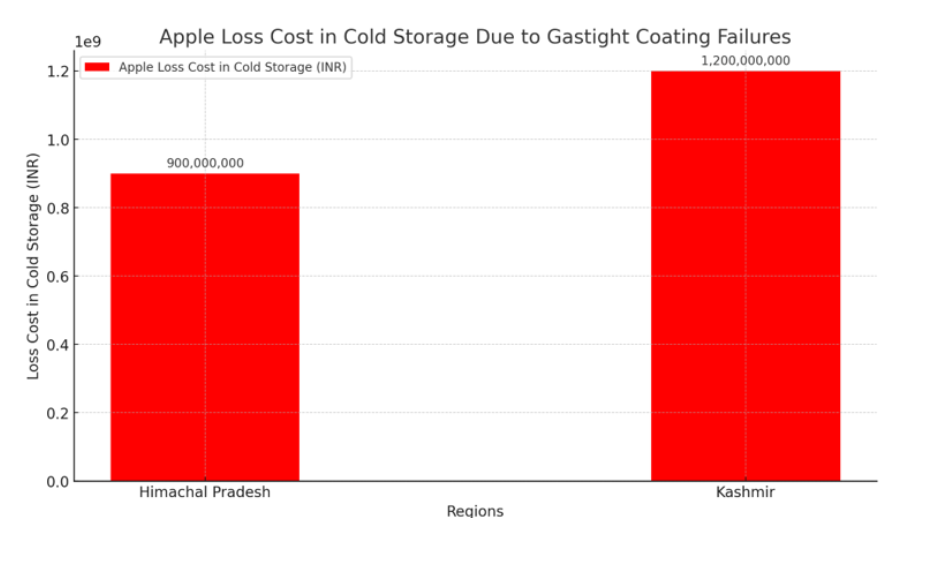
Spoiled Apples: The Ethylene Gas Problem Worth 210 Crore.
Gastight Coating Failures: The Hidden Cause of Food Waste.
Gastight coatings might not be something you think about every day, but when they fail, the
consequences can be severe. These coatings play a crucial role in various industries,
ensuring airtight seals, preventing gas leaks, and maintaining stable environments. When
they don't perform as expected, the impact on food storage—particularly in regions like
Himachal Pradesh and Kashmir in India—can be devastating, leading to significant food
waste and infrastructure damage.
Spoiled Apples: The Ethylene Gas Problem.
In the cool mountain regions of Himachal Pradesh and Kashmir, apple storage facilities face
a unique challenge: ethylene gas. This gas speeds up the ripening process, causing apples
to spoil faster. Studies have shown that even a concentration of 1 part per million (ppm) of
ethylene can significantly reduce the shelf life of apples. When gastight coatings fail,
ethylene builds up, causing apples to rot prematurely and resulting in considerable losses.
Research indicates that failed coatings can reduce apple freshness by up to 30%,
significantly impacting both storage and transportation.
Apple Loss Cost in Cold Storage.
-
Himachal Pradesh
-Loss in Cold Storage: 22,500 tons
-Cost of Loss: ₹900,000,000 -
Kashmir
-Loss in Cold Storage: 30,000 tons
-Cost of Loss: ₹1,200,000,000
The Technical Failures.
Gastight coatings rely on advanced materials like elastomers, polymers, and specialized
resins to form a seamless, durable membrane. The application process includes thorough
cleaning, multiple layers of coating, and rigorous testing. However, if any step is
compromised—such as insufficient surface preparation or improper curing—the coating's
effectiveness is drastically reduced. Studies show that a compromised coating can have
permeability rates exceeding 0.05 grams per square meter per day (g/m²/day), leading to
significant gas leaks and spoilage.
Inspection and Testing Shortcomings.
Ensuring the effectiveness of gastight coatings involves visual checks, electronic leak
detection, and gas permeability testing. However, inadequate inspections can miss defects,
allowing leaks as small as 0.005 g/m²/day to go undetected. This can result in significant
spoilage over time, as small leaks accumulate and compromise the storage environment.
Economic and Operational Drawbacks.
The failure of gastight coatings can lead to substantial economic losses. Companies face
costly repairs, product loss, and safety hazards. Additionally, maintaining controlled
environments becomes difficult, reducing energy efficiency and increasing operational costs.
Studies suggest that businesses can face up to a 30% increase in energy costs when
gastight coatings fail, highlighting the importance of reliable applications.
Addressing the Issue.
One company specializing in high-performance gastight coatings is Ribbstyle. Known for
their excellent adhesion, flexibility, and resistance to harsh conditions, Ribbstyle offers
coatings that aim to provide reliable, long-lasting airtight seals. However, even the best
coatings require proper application and regular maintenance to ensure effectiveness.
By understanding the potential failures and their consequences, industries can take
proactive measures to ensure the reliability of gastight coatings, ultimately reducing food
waste and enhancing operational efficiency.
References.
- Watkins, C. B. (2006). "The use of 1-methylcyclopropene (1-MCP) on fruits and
vegetables." Biotechnology Advances, 24(4), 389-409. - Smith, D. L., & Kotze, J. M. (1996). "Biological control of postharvest diseases of fruits."
Annual Review of Phytopathology, 34(1), 33-54. - Freeman, B. D., & Pinnau, I. (1999). "Gas and vapor transport in polymers." Advanced
Materials, 11(3), 199-211. - Stern, S. A. (1994). "Polymers for gas separations: the next decade." Journal of
Membrane Science, 94(1-2), 1-65. - Adams, M. (2009). "Energy efficiency in cold storage facilities." Energy Policy, 37(9),
3332-3341. - Balogh, J. C., & Walker, W. J. (1992). "Golf course management and construction:
Environmental issues." Lewis Publishers. - Hegedus, C. R. (1998). "Polymer science and technology." Journal of Chemical
Education, 75(11), 1424.

